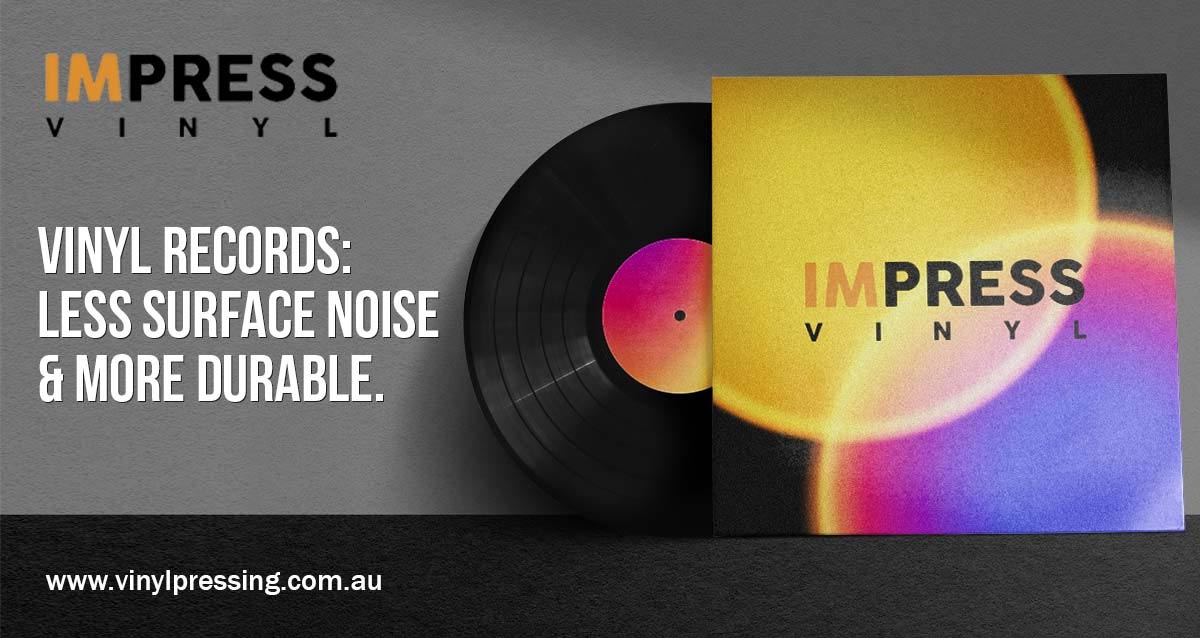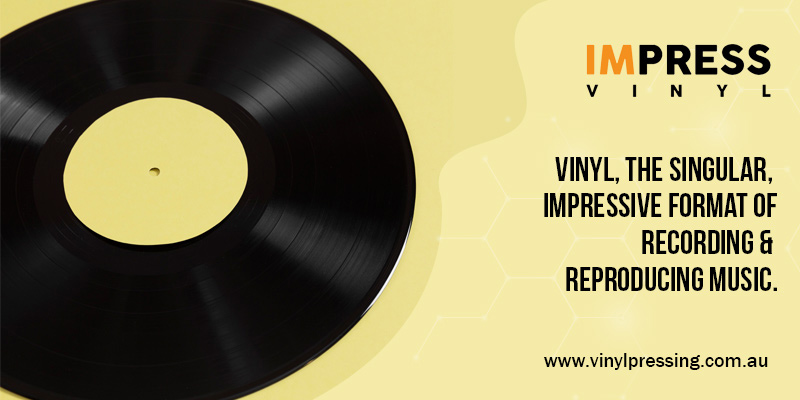12-Inch Vinyl Record Format: A complete History

What is a Vinyl Record Pressing Service?
A comeback of vinyl record pressing services
Let’s start from basic; In simple words, vinyl records are analogue audio storage medium in the form of round flattened disks where sound are carved in a spiral design. A needle on the rotating disks produces vibrations that turn into sound sent through the speakers.
Initially, vinyl record pressing services were made up of resin called shellac; nowadays, the company uses recyclable plastic, which is more durable and makes less noise, called Polyvinyl chloride(PVC), resulting in today’s vinyl records, vinyl disc records, or Vinyl in short.
Complete History of vinyl record reproducing sound and recording: the process of making vinyl music.
In 1877, a metal cylinder device was invented by Thomas Edison that could record sound and reproduce it for the first time called a phonograph cylinder. Later in 1889, a European named Emile Berliner introduced a playback sound recorder that played on the lateral cut-disk record, which is used as a medium for music reproduction termed “gramophone”, also called disc record long-playing, or record.
Starting in the 1940s and till the 2000s, polyvinyl chloride became more common in the modern-day era known as “vinyl”. If you are passionate about music or music production, Vinyl remains an awe-inspiring record that is an artistic, tangible, original, and beautiful form of recording and reproducing music.
Over the years, as technology evolved with vinyl record pressing in Australia, many music lover artists mastered developing vinyl discs concepts through modern-day technology, resulting in ultra-high-resolution discs.
How are vinyl record pressing made?
The making process of vinyl records pressing requires a studio with proper equipment and tools to master and create the fine analogue discs. Know how are Vinyl records made:
- The main piece of tool is called cutting lathe. It is cut to start the first step of the record-making process. Lacquer is a process where a machine physically carves the music grooves into an aluminium plate coated with cellulose nitrate.
- An engineer mastered in making the discs places an empty lacquer onto the lathe, and the machine transforms audio energy into the physical movement of a needle on the lacquer. The needle is tipped with a diamond or sapphire cutting head which carves the music into the middle of the platter in a spiral looping format.
- After these steps, the lacquer looks like a finished record; many similar lacquers are created and coated with nickel that is used to stamp out hundreds of duplicate records using Vinyl.
- Now, the lacquer is dipped into the solution to neutralize any oil or dust relied on its surface gently. A thin silver foil is evenly coated on the lacquer using a spray gun.
- Lacquer is again placed in a solution; now, electric current is induced to nickel molecules to the electrically conductive silver layered lacquer to create a negative plate called “father” or “master” plate.
- While the original lacquer with the positive charge, the audio can be played on the turntable is called the “mother” plate, which can’t be used to press records. “Father” plate used to press records and save as backup master as plates deteriorate during the pressing process.
- Before continuing the plating process, the plate is sent to an electroforming bath to test each side of the records. The negative plate is referred to as a “stamper” that stamps on your record, and the mother is played to check if it is free of defects and the audio meets the high-quality standards.
- Finally completing the piece of the puzzle, the records are packed and sent to stores and to consumers’ turntables, where they can enjoy the ultimate joy of music for years to come.

How do vinyl records make a sound?
To record and produce music, we need a well-equipped studio. Vinyl record pressing in Melbourne, where engineers and musicians work together to bring the finest audio quality to prepare their album.
Mastering vinyl record printing demands a knowledgeable person who knows the process with a trained ear. The audio, which results in a warm and depth tone, will distinguish it from digital-made music with modern technology.
Vinyl records printing are analogue, meaning the needle needs physical contact for playback. In this case, vibrations produce sounds and travel through the air. The airwaves transfers sound energy from their source to their surroundings. The human ear detects sound waves by the vibration of air particles that causes the eardrum to vibrate. The sound gets louder when there are more vibrations of air particles, and lower frequency results in wider grooves.
Different types of vinyl records are recognized today.
Four types of vinyl record printing are most common. Many use different sizes, shapes, and even colours and prints custom-made stickers on them.
- 12-inch Vinyl record Albums (LP or Long-playing): These are commonly known as Long Play or Long Playing records, thick and black coloured albums. LP plays at 33 1/3, and 45 RPM makes the sound quieter. The speed of vinyl records can affect sound quality.
- 7-inch Singles: Mainly used for jukeboxes where it sometimes holds one song on each side. It has the same song on both sides. 7-inch comes with small records but the 7-inch record has the same song on both sides. This comes with small records but large holes.
- 12-inch Vinyl Singles: These are more purchased by DJs because A side holds a single song of the album and B side holds the remixes or live recordings. It is more durable and still produced today.
- 10-inch Records: Earlier LP records are 10 inches. Classical music listeners need longer playback time, and pop music listeners require short playback time. 10-inch album consists of multiple LPs grouped to form a multi-disc album release.
Different RPM of vinyl disks
Apart from size, a better way to group discs is by speed. These are measured in RPM (revolutions per minute) on the turntable. Many speeds were brought out to match the quality of music. finally, the recording industry agreed to these standards for different sectors of music mediums.
- 78 RPM
- 33 RPM
- 45 RPM
Here are the reasons why you should choose vinyl records pressing in Melbourne
Custom Vinyl records pressing in Australia is famous for its classic custom made designs and sound quality. The key factors considered for good sound quality and durability are thickness, diameter, speed, and cleanliness.
Cool factor:
People who buy vinyl records are under 25. New millennials choose dated concepts making them relevant and cool again. Nowadays, trendsetters are using retro culture to look more attractive.
Sustainable:
Vinyl albums aren’t like new modern-day songs where you can download and listen anytime. It’s the feeling and touch of physical vinyl records we can collect and store your favourite albums in your home.
Listening experience:
It’s the 21st century where everyone prefers pocket-friendly earbuds and speakers they can carry anywhere they want. But, vinyl music lovers like to listen to music in traditional style; they still spend time and money on Hi-Fi setups in their homes. Vinyl lovers choose songs to listen to and enjoy rather than selecting autoplay in modern streaming services.
Sound Quality:
Unlike online streaming platforms, compressed audio formats have mixed low-quality audio. Vinyl is readily available on a physical outlet near your local area, old-school analogue audio that sounds superior.
Collections of Vinyl:
A new musical talent learns the art of music production by having years of experience. People choose their custom-made designs to manufacture personal vinyl collections. To have private collections of vinyl records means people grew up with Vinyl to reconnect with their youth.
Future of Vinyl records
Many people still choose cassette tapes, CDs, and MP3 players over online streaming services. Nowadays, these were replaced by digital cameras, phones and iPods. But the Vinyl is here to stay forever, much new advanced technology may come, but vinyl records aren’t digital. These are physical forms to look and feel, but they are not old. It’s classic.